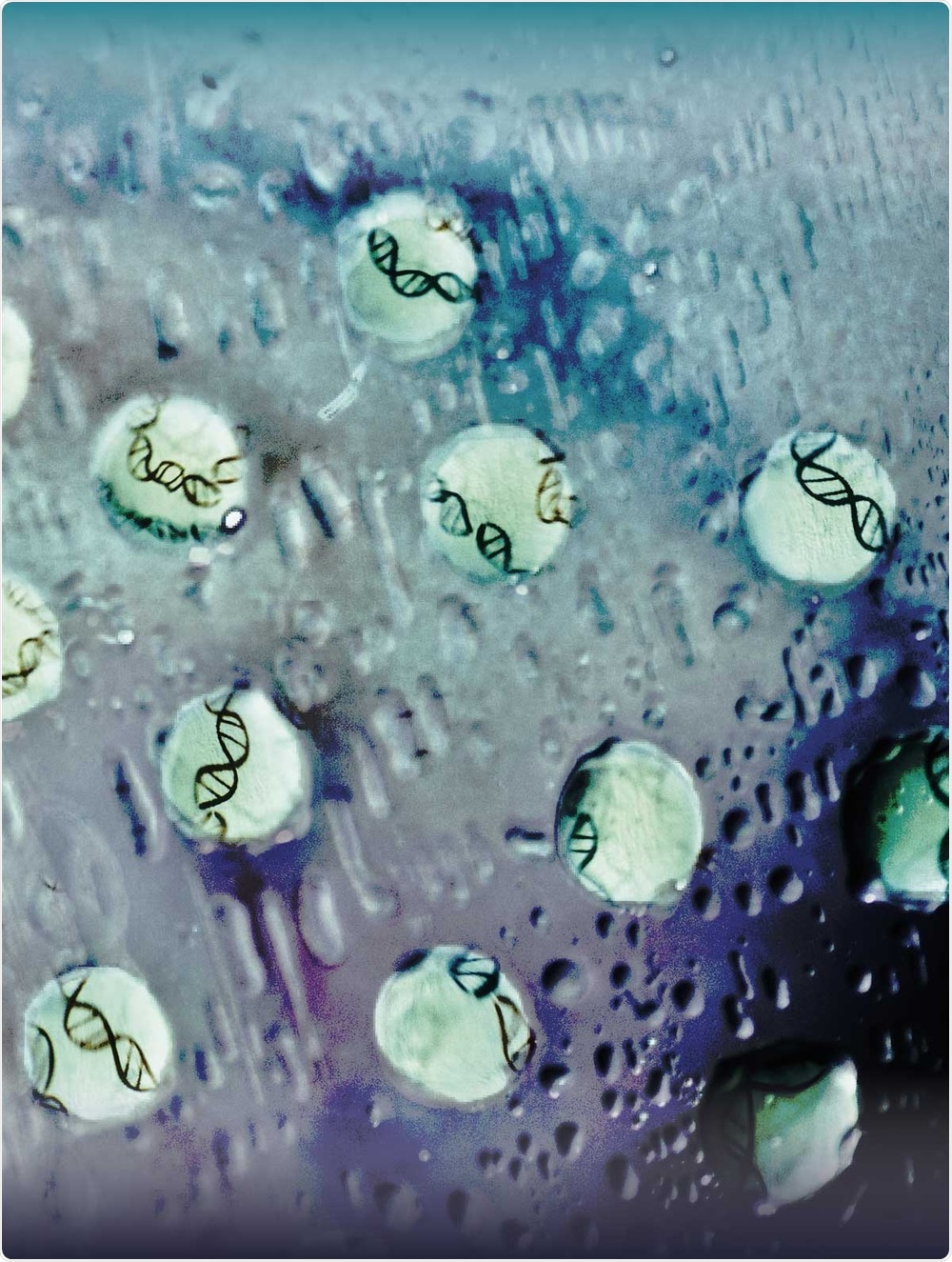A single cell forms the basis of life. As an organism grows, dividing cells specialize to produce the many tissues and organs that make up the adult body, all while maintaining the same genetic material—our DNA.
Parts of the DNA—the genes—are transcribed into a messenger molecule—the ribonucleic acid (RNA)—that carries the information needed to generate proteins, the building blocks of life, in a process known as transcription.

Droplets of transcription factors wet a surface and reveal regulatory DNA regions. This process is symbolized in this photograph of droplets of purified protein on a glass surface with hand-drawn DNA on the back of the glass. Image Credit: Mark Leaver, Jose A. Morin and Sina Wittmann, / MPI-CBG / Jose A. Morin et al. Nature Physics, 2022.
The cells’ fate is determined by the sections of DNA that are read and transcribed. Transcription factors, which bind to particular places on the DNA and trigger the transcription process, are the readers of the DNA. It is still unknown how they figure out which part of the DNA they need to connect to and how these are separated from other random binding sites in the genome.
Thousands of unique transcription factors join up and interact with each other, according to scientists at the Max Planck Institute of Molecular Cell Biology and Genetics (MPI-CBG) and the Max Planck Institute for the Physics of Complex Systems (MPI-PKS), both located in Dresden. They moisten the DNA surface collectively by producing liquid droplets that may detect clusters of binding sites on the surface.
One of the most essential biological processes is transcription, which involves the conversion of DNA information into the messenger molecule RNA. Later on, this “message” is translated into proteins. Because many illnesses are likely to emerge when genetic programming is not implemented correctly, determining which regions of the DNA are transcribed at any particular time is critical for normal growth and maintaining an organism’s health.
A complex network of regulatory proteins known as transcription factors determines which genes are transcribed. While these factors bind to short DNA sequences, switching on neighboring genes requires the identification of clusters of several such sequences.
In a recent study published in the journal Nature Physics, the research groups of Stephan Grill and Anthony Hyman, both directors at the MPI-CBG, and Frank Jülicher, director at the MPI-PKS, investigated how transcription factors find and recognize clusters of many specific DNA sequences where they can bind and lead to gene activation. The researchers used an interdisciplinary strategy to find out, combining experimental and theoretical biophysics with cell biology knowledge.
We employed optical tweezers—a technology that uses lasers to isolate and manipulate very small objects such as single DNA molecules—combined with confocal microscopy to look at them individually.”
Jose A. Morin, Study Author, Max Planck Institute of Molecular Cell Biology and Genetics
Jose A. Morin adds, “With optical tweezers it is possible to capture a single DNA molecule and with confocal microscopy we can observe transcription factors binding and forming protein condensates at their preferred DNA sequences. The fact that we can study this process one molecule at the time allowed us to detect interactions otherwise blurred by the complexity of the living cell.”
“With the help of the physicists, we were able to understand how transcription factors communicate with each other and assemble through team work. They undergo what is called a prewetting transition to form liquid-like droplets, which are similar to the drops on a mirror in your bathroom after a shower,” stated the researcher.
Sina Wittmann, the co-first author of the study remarks, “These condensates are filled with thousands of transcription factors. Assembled in this way, the transcription factors can now identify the correct DNA region by reading out DNA sequence.”
We now have a possible mechanistic explanation for the localization of transcription factors along the genome. This is essential to understand how gene expression is regulated. Since we know that this regulation breaks down in developmental diseases and cancer, these new results give us a clearer picture of how these diseases occur. This knowledge is important to think about new therapeutic options that take the team work of transcription factors into account.”
Stephan Grill, Director, Max Planck Institute of Molecular Cell Biology and Genetics
Anthony Hyman, Stephan Grill, and Frank Jülicher’s research laboratories are also linked with the TU Dresden’s Center for Systems Biology Dresden (CSBD) and the Cluster of Excellence “Physics of Life” (PoL). The MPI-CBG, the MPI-PKS, and the TU Dresden collaborate on the CSBD.
Physicists, computer scientists, mathematicians, and biologists collaborate at the multidisciplinary center to learn how cells coordinate their behavior to produce tissues and organs of a certain shape or function.
The TU Dresden Cluster of Excellence PoL aims to provide light on the physical rules that govern life’s self-organization into molecules, cells, and tissues. A cross-disciplinary team of scientists joins forces at the cluster, which is funded by the Deutsche Forschungsgemeinschaft (DFG, German Research Foundation), to investigate how active living matter organizes itself to give rise to life.
Source:
Journal reference:
Morin, J. A., et al. (2022) Sequence-dependent surface condensation of a pioneer transcription factor on DNA. Nature Physics. doi.org/10.1038/s41567-021-01462-2.